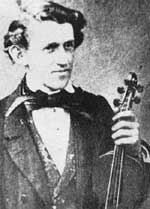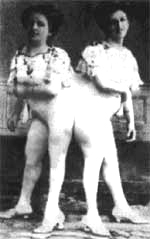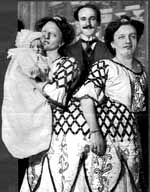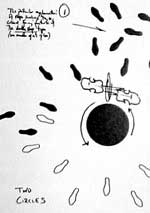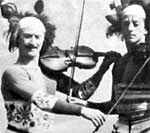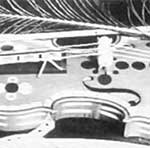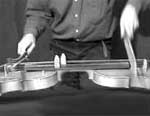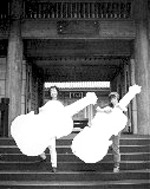 | |||||||

|
Double Violin Double Indemnity |
|
THE GENETIC TENDENCY IN VIOLIN MUSIC by Dr. Willy Orwig Professor of Genetic Marketing, MIT Those ethnomusicologists who were astonished by the revelations in my article for the World Music Journal in the January edition in 1969 (1) concerning the violin music of the Payawipaya people in Papua, New Guinea, may well take issue with what I am about to advocate here in this brief exploration of the relationship between musical structure and genetic function. However, I find that the recent dearth of imagination and end to experimentation in the area of so-called new music, let alone the lack of basic physiological knowledge that underlies the fundamentals of nearly all musical experience, has given me no other recourse than to speak out in the defence of Dr. Johannes Rosenberg. After pursuing a non-deterministic and polynominal analysis of Payawipaya musical principles in those trying and humid conditions of February 1952, Rosenberg pushed on further into the interior. He had witnessed, amongst the intoxicating wonders of this musical culture, an event that had struck even him as disturbing, not to say odd. Towards the end of one of the marathon violin playing sessions, the doctor had been summoned to a small ceremonial hut hidden away behind the main village campus. There, centrally positioned in the sweet, smokey gloom and surrounded by a quantity of freshly harvested pickled heads, sat a pair of Siamese (conjoined) twins playing a violin that had obviously been specially built for them! Overcoming his immediate disbelief, Rosenberg, in that decisive moment of realisation that is uniquely his, saw that he was looking at a violin tradition which brought together Cartesian resolution in a physical unity of expression hitherto thought beyond western music's (at least) contrapuntal discipline. Still reeling from this Damascus-like encounter, this master of the six-part invention was informed that the twins were not from the locale and had been captured on a punitive raid from the Batit Bati tribe 2 days further up stream. There, apparently, lived a people whose genetic disposition was to Ischiopagus or Pygopagus forms of conjoination (2). The Elders of The Bati Bati were as unsure as Rosenberg as to the main cause of the genetic predisposition to 'go Siamese'. Certainly they never ate brain stew and so did not suffer from the debilitating disease Kuru. However, he did note later that pregnant women (3) were kept right away from the double violin music, in effect demonstrating that the sonic extremes caused by the difference tones on the instrument of doubles, after years of jungle habitation, could exacerbate any inherent problem. Are we observing here another example of recursive decomposition perhaps? The thought of a whole gamelan-modelled string orchestra of the Siamese disposition and all playing Siamese violins was indeed mouth-watering for a former sickly but highly strung wunderkind who specialised early in polytonality (4). What kind of deviation to standard canonic mirror inversions would be possible in such an ensemble? Perhaps double mirror displacements? And since such rhythmic and tonal applications would be carried out by violinists, often joined at the spine, on two instruments that also shared a common spine (the neck), where would the rich tonal ambiguities lead? How could such instrumental perversion and technical facility have been developed in such a short period of linear time? Since the missionary origins of the violins in Papua were already known to Rosenberg by this time, he was being confronted by an evolutionary process with a blitzschnell timeline. The climate, too, had played its part in the way in which the violin instruments, originally made in Sichuan province China, had morphed into their new but ancient host culture. This, however, did not explain the rapid bifurcation of instrument design, only the warped necks. Other questions demanded the bow thrust of investigation. What role, for example, did the heavily decorated double violins play in the sex rituals of the Siamese?. As we know now, within ten years of the Rosenberg expedition, Shell Oil had arrived in the area and the entire population was refined down and sent by tankers worldwide to increase the productivity of some sweat shop in another third world disaster zone while some rich fat bastard got even richer and fatter (are you sure you want this included in the article? Ed.), so the answers to these questions have never been fully accessed. However, I would draw your attention to two pages of the master's field notes (5) Firstly, while kinesthetic reaction times of 110 to 130 were recorded on tests achieved with the Payawipaya, no such evidence can be attributed to the Siamese of the Bati Bati, so I would take issue with the late Yehudi Menhuin's assertion that Siamese violinists automatically inherit double the kinesthetic chemical components (SodiumBiosocPeroxide) and consequent finger sensitivity. There is simple no empirical evidence to support this. Secondly, the field notation of the Dak Dak Bak Violin dance shows an extremely large footprint in the top left corner of the choreographic chart. This is NOT to be taken as evidence of mutational rectitude, forced feeding of left feet, or lazy draughtmanship on the part of the doctor. If one leans closer to the now crumbling wax drawing, it becomes clear that we are dealing here with the ends of a double spiral! Yes, within the confined evolution of the (primitive?) Dak Dak Bak is the formidable truth and assertion of deoxyribonucleic acid or DNA. Extraordinary! Or is it? One can surmise that between the thousands of years of conflict between the Payawipaya and the Bati Bati when bow was plied with arrow as opposed to the beautiful descendant of Cremona, favour was bestowed upon families with the Siamese tendency. And you don't have to be a monk called Mendel to know that a tendency becomes an orthodoxy over time. It seems that within the code, the Floating Head Gene, the one that controls correct backbone formation, becomes mutant and chooses instead for Siamese. For the Bati Bati, seeing double and hearing double became a natural process of selection, need I say expectation. Or did it? When Rosenberg returned to Australia after the exhausting Paya expedition, his mind was burdened with how to introduce the Siamese musical model into the concert hall without it being seen and heard as a music hall novelty. The first problem was where to find a ready supply of Siamese twins (6) willing to learn the violin. Some readers, not used to Rosenbergian directives, might find this notion distasteful to say the least. But often new and radical ideas have been persecuted if not snuffed out by the religious authorities in musical history, one thinks of the musica diabolicus (7) or the pressure exerted on J. S. Bach to cut the length of his cantatas (ending in a heavy prison sentence at one stage). We are not dealing here with any juvenile Frankinstein conceit, but a rigorous quest to enable a delivery system that could, in any cultural dark age, set a road to recovery for all those who love the art of music. Not one to go halves and with the help of a few local private clinics, the doctor started his research into extra limb grafting but arrived, much to his surprise, at inferior results. This doppelmusik was not about body parts and superficial additions; it was concerned with the utilisation of auditory systems with often shared organs and persönlichkeit. Even with advanced surgical procedures (including upper castration), the motor output caused by the competing cortical centres and lower-lying subcortical regions like the basal ganglia and cerebellum generate the extremely fast and complicated data used in violin technique, and that reactivating violin limb transmission (or RVLT as it is known currently), cannot come close to bow simulation as a proven, practical, and reasoned resource. So ipso facto Rosenberg spent months staring into the darkness of the violin case for another way. Then, a colleague, the son of the Czech violin virtuoso Jan Kubelik, sent him details of the Blaûek twins. Rosa and Josepha Blašek, were born in Skrychov, Bohemia in 1878. These twins had a broad bony union in the lower part of the lumbar region, the pelvis being obviously completely fused (1). They had a common urethral and anal aperture, but a double vaginal orifice, with a very apparent septum. The sensation was distinct in each, except where the pelves joined. They were exhibited in Paris in 1891, being then on an exhibition tour around the world. Rosa was the stronger, and when she walked or ran forward she drew her sister with her, who must naturally have reversed her steps. Musically speaking, one could say that Josepha was always in retrograde motion. They had independent thoughts and separate minds; one could sleep while the other was awake. Many of their appetites were different, one preferring beer, the other wine; one relished salad, the other detested it; thirst and hunger were not simultaneous. Also one could feel like dancing while the other was sick, but if one took medication or practised scales for too long, the other certainly felt it. The music itself affected their performances--one might cry and the other express sublime happiness over the same violin line. Another moment and the emotions might be swopped between the twins. As one can imagine, this led to much confusion amongst the audience who were never sure as to the meaning of the music. Josepha played the violin left-handed, for which she needed special dispensation from the local party committee for 'correct musical behaviour'. They were noted for their performances of the Bach Double Violin Concerto in D minor and some more light-hearted duo pieces such as A Bicycle Built For Two (lollipops as Kreisler used to say). However, programme notes sent to Melbourne included descriptions of performances in which Rosa would play a popular tune from beginning to end while her Siamese sister would play it from the end to the beginning in perfect synchonisation. One set of programme notes even advertised the performance of Die Schwartze Augen played in compound meter of 13/8 (3+3+3+4) while twin played the same piece also in 13/8 but (4+4+5). Stories of romances are unsubstantiated, but it is known that Rosa gave birth to a son Frantioek in 1910, and it is rumored that after a tête(s) à tête(s), the baby's father wanted to marry Rosa but her parents objected and anyway the courts would not allow it, saying that the man would actually be marrying two women. What is beyond conjecture, however, is that Rosa's son married her conjoined sister. At the time of writing these notes, The Rosenberg Museum in Slovakia, under the direction of Dr. Jozef Cseres, is still trying to track down this violin descendant (8). Fascinating as all this was, Rosenberg wanted more than to compose a few witty double entendre miniatures (9). Mathematical synchroniscity was all very well but he was looking for a musical language which dealt with more subtle principles such as colliding tonal palettes caused by the slight differences in tuning regimes between the two (in one) violin instruments. He also considered the use of overlapping rhythmic motives which, although connected at the spine (as it were) practically and musically speaking, would always go beyond simplistic match and substitution in any diatonic sense. Perhaps the intense last movement of the Das Konzert des Doppelgängers with its pairs of hemi-demi-semi quavers points to the more reasoned solution. A Wittgenstein probe into the darker sides of duality, or is it? Rosenberg saw through that two-faced philosophical approach, he wanted to fuse together an animate sensibility caused by the fundamental vibrational link which was not possible through any other known musical device, a physical non mentis fixit. And so we arrived at an instrument par excellence: the 'Double' brings together in one instrument a cross vibrational experience missing from all previous string instruments to descend to us from that genesis and loci of world music, the banks of The Tigris and The Euphrates. Even today the ghost of Rosenberg still presses on into the interior. Although tuition in double violin technique is common throughout the tertiary musical establishment in Australia and Slovakia, there is still some reluctance internationally to accept the inevitability of Rosenberg's rational. One has only to see how the musical innovations of The Solomon Islanders (singing in parallel major seconds), The Bati Bati (double violin) and The Payawipaya (use of heads and tails to decide musical procedure) have been passed over to realise that what passes for the history of music continually misses the critical sign posts. For the purposes of this historic recording, all metal strings were used on the Rosenberg Double Violin, gut strings considered these days as something of an EU health hazard (10). Jon Rose is a specialist in 'all things Rosenberg', but even he has taken considerable care to adhere to performing protocol as laid out in the late Doctor's field notes of 1952. Generous to the core, he went halves on the cost of the electricity used in this recording. 1. In both Payawipaya and Bati Bati cultures, there is no sense of a beginning or end to proceedings. Structures are based on more tangible constraints such as the weather, wars (11), etc. Performances can last for hours when refreshments are plentiful. 2. Re-tuning and tonal adjustment are featured modus operandi throughout any double violin performance. 3. The two violin bows should be used one per hand (no matter how many hands there are); two bows in one hand is possible when manipulating a tuning wedge or peg. Rosenberg designed two double bow systems (see RM archives) so that two bows could be held in one hand easily. However, eventually he lost interest in the idea because of the limitations placed on the required spiccato applications. 4. Manipulation of the three tuning wedges is achieved by a swift thwack of either violin bow--it comes without any warning. The tuning wedge can also be twisted by hand for halftone steps (up or down), offering a more convenient approach to tuning than the pegs. 5. Since a wedge controls the pitch of two strings and thus four intervals, four part glissandi are possible in contrary motion, a favourite device of the Bati Bati. 6. The most common tuning regimes for the open five main bowing strings (unwedged) are as follows. A E A B C# G C D D# F# F# D C# D E But it seems clear that once the tuning wedges are inserted, consistency of control is abandoned for the unrepeatable colliding of tones technique and the chase the tone approach to find a new tonal centre which could arrive when the sympathetic strings start to excite for no apparent technical reason. The double violin is an open yet physically connected sonic system in which the vibrational complexities of one violin directly affect those of the other instrument (12). 6. The recording utlises the traditional lateral bowing technique of the Payawipaya, including polythythmic cycles of three against four, etc. The belly bow (fast pressured bowing that changes the pitch of open strings) is also used in this performance. 7. Stopping the music to sneeze or urinate in a nearby bush is considered de rigeur in Payawipaya circles (13). Notes: (1) THE PINK VIOLIN published by NMA, Melbourne. Pages 112 and 116. (2) An extremely rare form of identical twins that occurs perhaps in one out of every 75,000 to 100,000 births or 1 in 200 deliveries of identical twins, that of conjoined twins. Conjoined twins originate from a single fertilized egg so they are always identical and same-sex twins. The developing embryo starts to split into identical twins within the first two weeks after conception but then stops before completion, leaving a partially separated egg which continues to mature into a conjoined fetus. Pygopagus Twins are likely positioned back-to-back and usually have a posterior connecton at the rump. The tendency occurs in almost 20% of documented cases. The Blašek Twins were of this kind. Ischiopagus. About 6% of all conjoined twins have this condition, with the twins joined by the coccyx (lowest part of the backbone) and the sacrum (backbone immediately above the coccyx). Thoraopagus. The most common form of conjoined twins, occurring in between 35-40% of all cases. The twins share part of the chest wall, possibly including sharing the heart. Rosenberg reported no examples of this tendency amongst the Bati Bati. (3) At later performances on the 10-string double violin in middle Europe, it was common for members of the audience to vomit loudly and suffer inner ear headaches. The party central committee therefore never allowed Rosenberg to perform to pregnant women under the age of 65 or to rank and file members of the party youth movement. Nevertheless, visitors to The German Democratic Republic often noticed the ubiquitous doppelkinderwagen (double prams) in use up and down the country, a sign of a thriving conjoined twin population. (4) Writing for and able "to discern a 10 cent differential between four sets of simultaneous minor thirds" according to that lion of the Helmholz School, Dr. Boris Von Weingarten. (5) Now, thankfully, in the possession of the Rosenberg Foundation, Melbourne--sometimes these things takes a while! (6) Named after the Chinese-looking conjoined twins Eng and Chang Bunker, the original Siamese Twins 1811-74. The age of novelty ensured a career on the boards and in the circus tent. (7) Musica Diabolicus was the tritone interval or the sound made by string players struggling to get their fifths somewhere near to the perfect. The Catholic Church were adamant in banning its use through the 12th and 13th centuries. (8) On March 30, 1922, 34-year-old conjoined twin Josepha Blaûek died of jaundice in Chicago with her sister Rosa succombing two days later. Further information on the Blaûek twins is available from The Rosenberg Museum, Slovakia. (9) The Blašek twins may have been too early for such titles as Tea for Two but the author feels that Rosenberg would have been capable of developing the double or quits theme. Along with the common cold, Split Personality used to be a recognised malady in parts of Central Europe for which the state doctor provided a standard perscription of Aspirin. It has been a common theme for composers such as Smetana, Janáèek, Dvoøák, and even the Russian Scriabin. (10) The Violin(s) itself(s) is in fact a copy constructed in 1980 by the performer himself(s) from Chinese Sky Lark Violins, following precisely the master's detailed drawing and instructions. The original Double Violin was confiscated by the East German secret police in 1975 and has since disappeared. A search throughout the Stasi files in 1990 revealed no trace or record for the instrument. The copy of the 'Rosenberg Double' resides in the Rosenberg Museum along with some 10 other violin mutations, including the 19-string violoncello. (11) War has always played a significant part in music performance. One thinks of Joshua at Jericho, Beethoven in Vienna and Gottschalk trying to get his gig in (on a day off) at the Battle of Gettisburg in the American Civil War. However it must be said that almost all music performances of The Payawipaya were brought to full tempo and then a halt with an outbreak of fighting. (12) Due to the concentration of frequencies in the 'Chinese' register, playback of this recording at levels above 75 db can cause vomitting and emissions of blood from the nose and ears. The Rosenberg Museum advises restraint. (13) This sociological construct was ignored for the sake of public hygiene in this recording. |
 |
